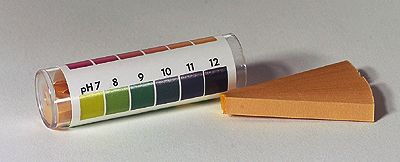ApchemWiki | RecentChanges | Preferences
The Following is the 1st year webpage, [1st Year pH Indicator Information] copied for your information. So if you have used the link and viewed the webpage or know the information, then skip the information in between the lined area and go to the bottom of the 2nd line.
1st Year Information
What does a pH indicators do?
- Answer: As the name says, it indicates a pH. It does not determine if the solution is Acidic, Basic or Neutral.
How does it indicate a pH?
- At a specific pH, it changes from one color to another (or no color called colorless).
Why does a pH indicator changes colors?
- Every pH indicator (it is actually a weak acid, so it has a pKa) has an endpoint, and the color with change from the "acid form" color to the "base form" color as the solution pH goes by the endpoint (also a pH value). It is actually pH+ or - 1.0 units of pH. So the endpoint is actually a range not a point.
For example, the endpoint of the specific pH indicator is pH = 5.0, and the indicator changes from red ("acid form" color) to green ("base form" color). If I have a solution with this pH indicator in it and the initial pH is 2.0, then the solution is red. If I increase the pH, the solution will stay red until pH of 4.0 where it will start changing from a "pure" red to a mix of red and green until pH = 6.0 where the solution will be "pure" green. The solution will stay green for all pH above 6.0.
So, each pH indicator "changes" color at a different pH point (or more specifically range). So the pH indicator shows that the solution has "gone" thru that pH (called endpoint). As the following link shows most pH indicators (and their endpoints and the color changes) are not at a pH of 7.0. So not all pH indicator will determine if the solution is acidic (solution pH less than 7.0), neutral (solution pH of 7.0) or basic (solution pH of greater than 7.0). They will however, show if you are at a specific pH range.
Actual pH Indicator and pH paper
- Litmus paper (either blue or red paper) is the same thing. The pH indicator is litmus that is red in the "acidic form" and blue in the "basic form".
- Phenolphthalein - colorless in the "acidic form" and red in the "basic form". Endpoint is about pH=9.0. It is the most common pH indicator for titrations in 1st year high school chemistry class.
- pH paper (see below image for pH paper) is actually a series of pH indicators that the combined colors will produce a single color so that every pH has a different color (comes with a pH vs. color scale). The solution used to make pH paper is called the Universal indicator (as stated before, it is actually a mixture of several pH indicator with different endpoints. So the color you see is actually a mixture of various colors).

If you used the link to the webpage showing pH indicators, one realize that there are a large number of pH indicators with a variety of endpoints (pH where they change colors). Also, as the above information states, pH indicators are weak acid. As you know, a weak acid and its conjugate base makes a buffer solution. The pH of the buffer solution can be calculated by using the Henderson-Hasselbalch (H-H) equation
pH = pKa + log ( [A1-] / [HA] )
The weak acid form is one color and its conjugate base form is another color. As you know, when the [A1-] = [HA] you are at the half-way point and the pH = pKa. Theoretically, this is where the solution should be changing color (there is equal "amount" of both colors. However, we "see" the resulting color.
Question: So how much more of color form do you need compared to the other color form so that one color predominates?
Answer: 10 times or 1/10 times. So in the H-H equation the term log ([A1-] / [HA] is 1/10 or 10/1. But since we are looking at logs, 1/10 or 10/1 is really + or - 1.0 log unit or in this case + or - 1.0 pH unit.
So we say that the range of the endpoint of a pH indicator is pH = pKa +/- 1.0 units.
How do I choose the correct pH indicator for solution or a specific titration?
The general Rule is: The Endpoint of the pH indicator should equal the Equivalence point of the solution.
A math simplified question would look like, what should be the Ka of the pH indicator of a solution that has a pH at the equivalence point of 9.0?
Answer: Since the pH of the equivalence point is 9.0, then the pKa of the endpoint of the pH indicator needs to be 9.0. So the Ka is 1.0E-9. So you go to the pH indicator chart/table and find a pH indicator that fits that information.
With respect to pH titration, as you know strong acid/base has a wider range of pH that the solution goes thru at the equivalence point that weak acid/base (the weaker the smaller the range of pH the solution goes through at equivalence point). So, for weak acids/bases it is very important to find a pH indicator that has an endpoint close to or equal to the pH of the equivalence point ( strong acids/bases, not so much).
